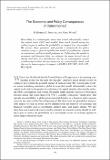The Economic and Policy Consequences of Catastrophes
Author(s)
Pindyck, Robert S.; Wang, Neng
DownloadPindyck_The economic.pdf (632.4Kb)
PUBLISHER_POLICY
Publisher Policy
Article is made available in accordance with the publisher's policy and may be subject to US copyright law. Please refer to the publisher's site for terms of use.
Terms of use
Metadata
Show full item recordAbstract
How likely is a catastrophic event that would substantially reduce the capital stock, GDP, and wealth? How much should society be willing to pay to reduce the probability or impact of a catastrophe? We answer these questions and provide a framework for policy analysis using a general equilibrium model of production, capital accumulation, and household preferences. Calibrating the model to economic and financial data, we estimate the mean arrival rate of shocks and their size distribution, the tax on consumption society would accept to limit the maximum size of a catastrophic shock, and the cost to insure against its impact.
Date issued
2013-11Department
Sloan School of ManagementJournal
American Economic Journal: Economic Policy
Publisher
American Economic Association
Citation
Pindyck, Robert S, and Neng Wang. “The Economic and Policy Consequences of Catastrophes.” American Economic Journal: Economic Policy 5, no. 4 (November 2013): 306–339.
Version: Final published version
ISSN
1945-7731
1945-774X